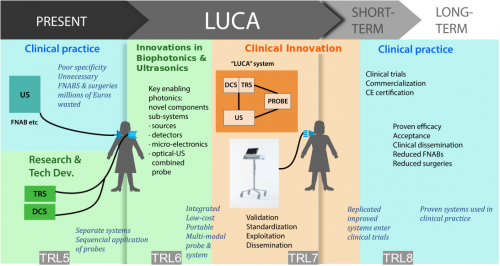Context
Thyroid cancer is a major and growing health challenge with around three hundred thousand new cases diagnosed worldwide annually. Current methods do not provide sufficient support to surgeons in their decision on the appropriate course of action, which leads to significant number of unnecessary surgeries and a reduced quality of life for patients. This calls for an increased sensitivity and specificity of the conventionally applied screening process.
The project partners therefore aim to develop a novel, point-of-care, low-cost device for the screening of thyroid nodules for an early and fast diagnosis of malignant cancers and an improved specificity of the screening process making it superior to the conventional ultrasound-based workflow. Once successful, LUCA will have an important socio-economic impact, diminishing the number of unnecessary surgeries and the associated comorbidities as well as improving the quality of life of patients.
The LUCA Vision

The objective of this multi‐disciplinary, technology innovation project is to develop a multi‐modal instrument that is made possible by two key enabling photonic technologies ‐‐ diffuse correlation spectroscopy (DCS) and near‐infrared time resolved spectroscopy (TRS) – and combining these technologies in a clinical ultrasound (US) probe. This system will be for the screening of thyroid nodules for early and fast diagnosis of malignant cancers to improve the specificity of the screening process compared to the conventional US based work‐flow. The LUCA partners aim to do this while keeping within the range of the cost of US devices and not reaching to the next level of more expensive modalities. The goal of LUCA is to start at a technology readiness level (TRL) of TRL 5 and move to TRL 7.
More specifically, the project aims to:
- develop a novel low-cost tool for the screening of thyroid nodules for malignant cancers
- develop an innovative probe that combines diffuse optics and clinical ultrasound for simultaneous multi‐parametric ultrasound imaging and optical measurement of tissue hemodynamics and composition of the thyroid nodules
- develop a multi-modal, point-of care device which integrates with the probe developed and a portable, low-cost ultrasound system
- establish the clinical usability of the LUCA device
Project output and deliverables
LUCA will develop the following output and exploitable deliverables, representing significant innovation potential:
- Innovative components and sub‐systems to reach the clinically expected specifications (accuracy, precision) while being a low‐cost system appropriate for point‐of‐care deployment
- A novel demonstrator that integrates the sub‐systems produced within the project into a system that can be tested in real‐settings
- Validated sub‐systems and demonstrator using tissue simulating optical/ultrasound joint phantoms
- Standardization and calibration procedures and protocols
- Clinical protocols and pilot study on clinical usability of the LUCA device
Impact
With the development of the LUCA device, we will achieve a major leap in thyroid cancer screening, which will lead to:
- Improvement in the specificity of the thyroid screening process compared to the conventional ultrasound-based workflow
- Earlier and faster diagnosis for an effective treatment and management and reduction of the number of surgeries
- Potential application of the LUCA device in other types of cancer diagnosis, screening and therapy monitoring (in areas of the body accessible to both techniques )
- Reduction of socio-economic cost related to thyroid cancer
- Wide-market introduction of the LUCA technology
The LUCA device has the potential to represent a very innovative tool for other types of cancer diagnosis, screening and therapy monitoring in areas of the body accessible to both ultrasound and near-infrared diffuse optical technologies. LUCA is therefore expected to have a significant impact on the field of thyroid cancer but also additional areas of cancer screening.
